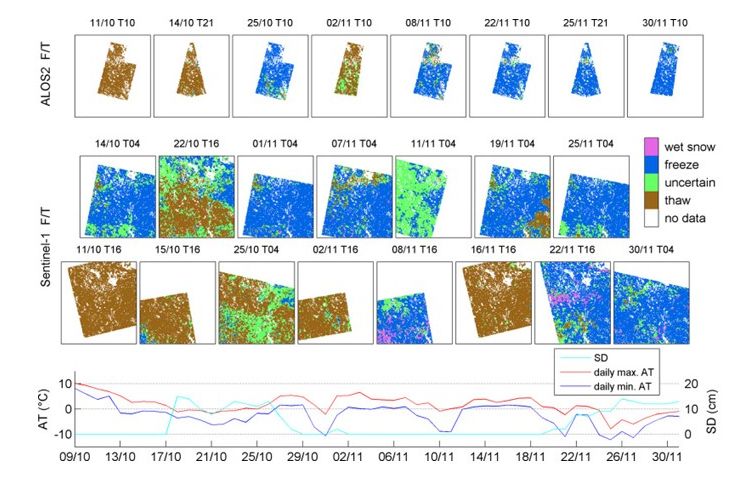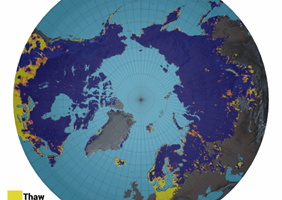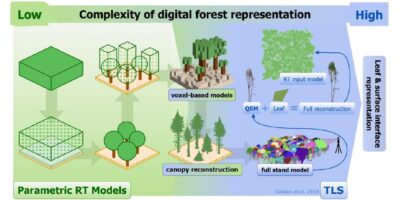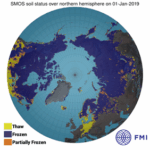The new study presents significant improvements to the existing methods, such as taking into consideration changes in the summer season. Soil F/T information is useful, for example, for users of heavy equipment, such as forestry machines. Soil freezing has a significant effect on the bearing capacity.
Soil freeze/thaw (F/T) state in the boreal forest was mapped using microwave L and C band SAR (Synthetic Aperture Radar) satellites. The study showed that the F/T state can be detected with good accuracy at both frequencies. The lower frequency L band is more suitable for soil F/T state detection, as it is less sensitive to vegetation and snow cover, and it allows deeper penetration into the soil. However, the weaknesses of the C band can be compensated by taking into account also the signal returning from the tree canopies in the calculation algorithm.
Studies on the detection of soil F/T state with C band SAR satellites have been conducted previously in the Finnish Meteorological Institute. The motivation for these studies increased after the availability of continuous and free data collected by the European Copernicus Sentinel-1 satellites. Based on the conducted research, a soil F/T product based on Sentinel-1 satellites covering almost the whole of Finland has been developed. The new study presents significant improvements to the existing methods, such as taking into consideration changes in the summer season, a more advanced classification algorithm, and wet snow information.
The availability of satellite L band SAR data is currently limited, but the European ROSE-L and American-Indian NISAR radar satellites planned to be launched in the next few years will offer a good opportunity to monitor the F/T state also at a lower frequency. The unique and comprehensive SAR dataset collected with the Japanese ALOS-2 satellite used in the research allowed the development of methods for soil F/T monitoring with L band in the boreal region already in advance.
The research was conducted in two phases
In the first phase of the study we investigated the influence of soil and vegetation conditions on the backscatter, namely the intensity of the returning radar signal from the object. In particular, we focused on the effect of canopy freezing and backscatter changes from spring to autumn, because these topics have not yet been properly studied, although they are important in soil F/T state retrieval.
In the second phase, monitoring of soil F/T state was demonstrated for selected test areas in Finland. First, a forest model separating the backscatter contributions from the ground surface and the canopy was applied to the satellite observations. Then, suitable reference satellite acquisitions representing autumn (thaw), winter (freeze) and spring (thaw) conditions were identified. Finally, these were used in the classification algorithm to distinguish between frozen and thawed conditions, also utilizing automatic in situ measurements of air temperature and snow depth.
Wet snow can prevent microwave radiation from reaching the ground surface. Hence, wet snow was detected as well, using the radar backscatter, air temperature and snow depth data, for enabling reliable estimation of the soil F/T state during the end of the winter. In the validation of the results, e.g. soil temperature and moisture measurements near the Arctic Space Centre located in Sodankylä were utilized.
More information
Researcher Juval Cohen, Finnish Meteorological Institute, juval.cohen@fmi.fi
The research article is available from: Detection of soil and canopy freeze/thaw state in the boreal region with L and C Band Synthetic Aperture Radar – ScienceDirect
J. Cohen, J. Lemmetyinen, J. J. Ruiz, K. Rautiainen, J. Ikonen, A. Kontu, J. Pulliainen. “Detection of soil and canopy freeze/thaw state in the boreal region with L and C Band Synthetic Aperture Radar”. In Remote sensing of environment. https://doi.org/10.1016/j.rse.2024.114102








Leave a Reply
You must be logged in to post a comment.